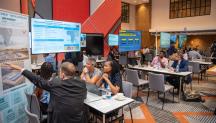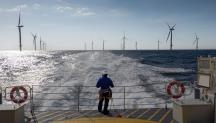

Wind Power: Technology brief
Newsletter
The size of wind turbines has continuously increased over several decades to boost power generation from this key renewable energy source. As this technology brief from IRENA and IEA-ETSAP notes, large-scale wind farms and larger turbines drive the ongoing reduction of electricity costs.
Onshore wind power generation, with costs largely confined to turbines, installation and maintenance, has become highly cost competitive against new-built conventional power plants. Offshore wind plants, while requiring greater investments in construction and grid connectivity, show long-term promise for high volumes of sustainable power generation.
Weight reduction, aerodynamic efficiency, and material selection are all important factors to reduce wind costs both onshore and offshore. Detailed aerodynamic analysis of turbine blades and the development of lighter, stronger materials is essential to improve efficiency even more.
Policy makers, meanwhile, can reduce regulatory risks by ensuring predictable time frames and putting appropriate frameworks in place for wind development. Wind developers can strengthen their investments by undertaking and following proper environmental impact assessments at the start of each project.
See other renewable energy technology briefs.




